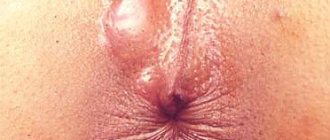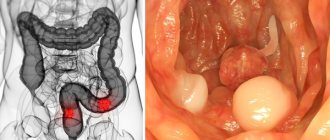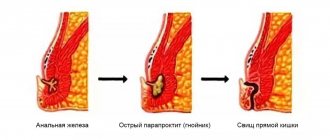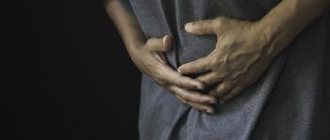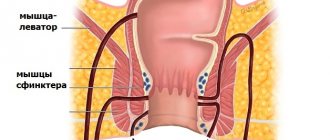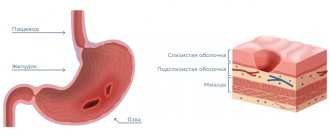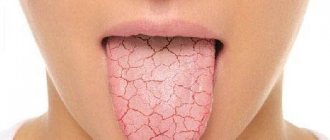Branch
An anal fissure is a defect in the form of a tear or open wound (ulcer) in the lining of the anal canal.
The anal canal is the final part of the large intestine, located between the rectum (the reservoir of stool) and the anus, through which stool passes out.
Symptoms of anal fissure
The most common symptoms are:
- acute pain at the time of defecation, which is accompanied by burning pain and can last for several hours.
- bleeding after bowel movements, which most people characterize as a small amount of scarlet blood in the stool or traces of blood on toilet paper.
When to go to the doctor
Go to the doctor if you think you have an anal fissure. Put aside the embarrassment, the problem of anal fissure is the third most common problem in the structure of diseases of the colon.
In most cases, anal fissures do not require any specialized treatment. However, contacting a specialized specialist will help rule out other diseases that occur under the guise of an anal fissure.
The doctor will also provide recommendations for individual treatment that will help relieve your symptoms and reduce the risk of relapse of the disease.
How is an examination performed for anal fissure?
The doctor will ask you about your symptoms and find out the nature of your pain. He may ask you about the frequency and nature of bowel movements. And, for sure, the doctor will need to examine the crack itself, by carefully spreading the buttocks.
When diagnosing an anal fissure, digital examination of the rectum is not always performed, as it can be painful.
If, in the opinion of a coloproctologist, an anal fissure is a manifestation of any of your other diseases, he can expand the examination and involve other specialists in consultation.
An extended examination may include a more detailed examination of the anus using an anesthetic to reduce pain.
In some cases, with fissures that are not amenable to conventional treatment, it is necessary to assess the tone of the anal sphincter (the sphincter is a muscular ring that opens and closes the anus).
What causes anal fissure?
— Constipation is the most common cause. Hard or large-volume fragments of feces damage the lining of the anal canal.
Other possible causes of anal fissures include:
- prolonged diarrhea.
- inflammatory diseases of the colon such as Crohn's disease and ulcerative colitis.
- pregnancy and childbirth.
- in some cases, sexually transmitted infections such as syphilis and herpes.
- a state of strong contraction (spasm) of the anal sphincter, leading to increased pressure in the anal canal, which contributes to its damage.
In many cases, the cause of an anal fissure is difficult to determine.
Who gets sick?
Every tenth person will develop anal fissure at one time or another in their lives.
Men and women of all age groups are equally prone to the formation of anal fissures. However, in most cases, cracks occur in children and young people aged 10 to 30 years.
Treatment and prevention of anal fissures.
Anal fissures usually heal within a few weeks or more without any treatment. However, the relapse rate is very high if the underlying cause of their occurrence, constipation, persists.
In some patients, symptoms of anal fissure may persist for 6 weeks or more (chronic form of the disease).
Measures taken independently by patients aimed at making stool easier can speed up the healing of existing cracks and reduce the risk of developing new cracks in the future.
To reduce pain, you can take regular painkillers (paracetamol or ibuprofen). Take warm baths for the perineum several times a day, preferably immediately after bowel movements during bowel movements.
Your doctor may recommend additional medications that will reduce the severity of your symptoms and help speed up the healing process.
The treatment regimen may also include pain-relieving ointments and laxatives, which make bowel movements easier.
Surgical treatment may be recommended for long-term non-healing cracks that are not amenable to conservative measures.
Surgery is an effective treatment for anal fissure in most cases. But, like any other operation, it can lead to complications, such as temporary or permanent loss of bowel control (incontinence of stool and gas).
Treatment of anal fissures.
Like any minor cuts or breaks in the skin, anal fissures often heal on their own within a few weeks.
However, if you have an anal fissure, it is better to consult a doctor who will prescribe you the necessary treatment, which will help you quickly get rid of the symptoms of the disease and make a full recovery.
Most anal fissures can easily recur after conservative treatment if you do not follow the recommendations below.
Independent activities.
There are several independent measures to relieve constipation, which in turn helps reduce pain with anal fissures.
Eliminating constipation allows you to heal an anal fissure and reduce the risk of its further development in the future.
Self-help measures to relieve constipation:
- Increase your daily dietary fiber intake by including high-fiber foods such as fruits, vegetables and whole grains.
- Avoid dehydration, drink more fluids and just water.
- Get more exercise. For example, take a daily walk or jog.
- Choose a convenient place and time when you can comfortably go to the toilet to have a bowel movement.
- Don't put off going to the toilet if you feel the urge to defecate.
- If you use wet wipes, make sure they do not contain fragrances or alcohol, which may cause discomfort or itching. If you use toilet paper, choose a soft variety and avoid using too much pressure when wiping.
- Take warm perineal baths several times a day, especially after bowel movements. This helps relieve spasm of the anus muscles.
Drugs.
There are a number of different medications that can be recommended by your doctor to reduce the symptoms of an anal fissure and speed up its healing.
Laxatives
Laxatives are a group of medications that promote freer passage of stool.
Adult patients with anal fissure are prescribed drugs that increase the volume of intestinal contents and osmosis.
Children with anal fissure are prescribed liquid forms of osmotic laxatives.
As a rule, treatment begins with small doses of laxatives. If necessary, the dose of the drug is increased every few days until loose, soft stools are established with a frequency of 1 time per day or 1 time every 2 days.
Attention! Without dieting, laxatives only help for a limited period of time. Do not use them for more than 7-10 days.
Painkillers
If you have prolonged burning pain after bowel movements, your doctor may recommend regular over-the-counter pain relievers such as paracetamol or ibuprofen.
But remember that some painkillers can cause constipation. Read the instructions carefully.
Ointment with nitroglycerin (glyceryl trinitrate)
If your symptoms do not go away within a week or two, you may be prescribed a topical ointment containing nitroglycerin. The ointment is applied directly to the crack area, usually 2 times a day.
Glycerin ointment promotes the expansion of blood vessels in the tissues surrounding the anus, which promotes better blood supply to the tissues in the fissure and, as a result, faster healing.
The use of these ointments leads to a decrease in pressure in the anal canal by relieving muscle spasms, which helps reduce pain.
Most acute anal fissures that last less than 6 weeks are cured with nitroglycerin ointment. In approximately seven cases of chronic anal fissure out of ten, with the correct use of nitroglycerin ointment, recovery occurs.
A common side effect of using nitroglycerin ointment is headache, occurring in 50% of patients.
Some patients experience dizziness or slight disturbances of consciousness after applying nitroglycerin ointment. Therefore, the ointment should be used with caution in children, pregnant and lactating women.
If you are bothered by headaches, you should reduce the amount of ointment applied. Using a small amount of ointment 5-6 times a day may be more effective than applying a large amount of ointment twice.
Apply the ointment only to the skin around the anus. Avoid getting the ointment into the anal canal.
As a rule, the duration of treatment with nitroglycerin ointment is approximately 6 weeks or continues until the crack is completely healed.
Local anesthetics
If you are experiencing severe pain, you may be advised to use a local anesthetic to reduce the sensitivity of the anus before bowel movements.
Local anesthetics are applied directly to the affected area. Their use does not have a direct therapeutic effect, but helps relieve pain.
The most commonly used anesthetic to treat anal fissure is lidocaine. Used as an ointment or gel. The duration of treatment is 1-2 weeks. As a rule, healing occurs within this time frame.
Calcium channel blockers
Calcium channel blockers, such as Diltiazem, are drugs commonly used to treat high blood pressure (hypertension).
At the same time, the effect of calcium channel blockers extends directly to the tissues around the anus, providing a proven positive effect in the healing of anal fissure in some patients.
Topical use of calcium channel blockers helps relax the anal sphincter muscles and improve blood flow in the tissues surrounding the anal fissure.
Side effects of calcium channel blockers include headache, dizziness, itching and burning at the site of application. All side effects of the drug disappear within a few days after use.
Topical calcium channel blockers are as effective as nitroglycerin ointments and are prescribed when other drugs do not help.
The duration of treatment with topical calcium channel blockers, as well as nitroglycerin ointment, lasts on average 6 weeks or until complete healing.
Botulinum toxin injections
The use of botulinum toxin in the treatment of anal fissure is a relatively new method of treatment. The method is used when other treatment methods are not effective. Botulinum toxin is a strong poison that is safe to use in small doses.
Botulinum toxin injections for anal fissure are performed in order to achieve paralysis of the anal sphincter muscles. This prevents muscle spasm, relieves pain and promotes healing of the crack. Currently, evaluation of the effectiveness of botulinum toxin in the treatment of anal fissure is ongoing.
The effect of botulinum toxin lasts for 2-3 months. This time is usually enough for the anal fissure to completely heal.
Observation
After several weeks of treatment, you should visit your doctor again. He will objectively assess the dynamics of the disease.
If the crack has completely healed, your doctor will schedule a follow-up examination in a few weeks.
If your anal fissure is a complex case and does not respond to treatment within 8 weeks, a consultation with a coloproctologist is necessary. He will assess the presence of indications for surgical treatment.
Operation
Surgical treatment is recommended if conservative treatment methods are ineffective.
Surgery is considered the most effective method for anal fissure, allowing to achieve good long-term results in 90% of cases. At the same time, there is a risk of complications.
There are a number of surgical operations used for anal fissure.
Lateral sphincterotomy
The lateral sphincterotomy technique involves making a small incision in the circular muscles of the anal sphincter, which reduces tension in the anal canal. Reducing stress promotes healing of the damage and reduces the chances of cracks reoccurring.
This is a relatively simple operation that is performed under general or epidural anesthesia. This means that you do not feel pain during the operation. Most often, the patient is in the hospital for the duration of the operation and a short period after the operation.
Lateral sphincterotomy is one of the most effective surgical methods for treating anal fissure with good long-term results. Most operated patients recover completely within 2-4 weeks.
Some patients (about 5%) who have undergone such an intervention are faced with the problem of incontinence of loose stools and gases as a result of damage to the muscular structures of the anal sphincter. Sphincter function recovers on its own within a few weeks.
Replacement of the defect with a skin flap
Skin flap surgery involves moving a piece of blood-supplied skin from another area of your body to the site of the anal defect to improve blood circulation in the tissues surrounding the crack.
This operation is recommended for the treatment of long-term anal fissures caused by pregnancy or trauma to the anal canal.
What is an anal fissure?
Anal fissure is a disease of the rectum when the mucous membrane of the anal canal is damaged. It is expressed in the form of cracks or ulcers at the border where the skin and mucous membranes come into contact. The wound itself is small in length - about one centimeter. After hemorrhoids and paraproctitis, it is the most common complication among diseases of this group.
Most often, this pathology is accompanied by the presence of hemorrhoids.
Anal fissure is a disease of young women, as well as men with non-traditional sexual orientation.
Using homemade ointments
If you wish, you can make effective and efficient ointments for the anal wound yourself. To do this, you need to use the following components: aloe juice, honey and several streptocide tablets. All ingredients must be mixed thoroughly (pre-crush the tablets), and then apply the product to the inflamed area.
An ointment based on badger fat and propolis has quite good healing and anti-inflammatory properties. In this case, the mixture must be injected directly into the rectum using a cotton swab. Crushed chamomile flowers, which can be mixed with a teaspoon of honey and fish oil, also work well on cracks and sores in the anus. Applications with this mixture should be done for 7-10 days every evening after taking warm sitz baths.
Surgery
Excision of anal fissure
Using a scalpel, laser or electrocoagulation, the altered tissue of the anal canal is removed (removal of fissures, hypertrophied anal papillae, skin fimbriae, as well as fistulas, if any). A triangular tissue incision is formed in the perianal area, which allows for wound drainage. The wound is not sutured, it is left open, this promotes better healing and reduces pain in the postoperative period. The use of this technology results in a very low relapse rate.
Mandatory for this treatment is strict adherence to postoperative recommendations using drugs for medical sphincterotomy.
Sphincterotomy
Partial dissection of the posterior portion of the internal sphincter with the intention of reducing the tone of the anal sphincter, because according to many authors, an increase in the tone of the internal anal sphincter explains the pathogenesis of the anal fissure.
The disadvantage of this method is a persistent deterioration in holding function. Unnoticeable in the first years after surgery, but which can manifest itself at a later date.
Contraindications
Sphincterotomy is contraindicated in patients who suffer from fecal incontinence (inability to retain gases or feces).
Preoperative anorectal manometry provides information about possible sphincter muscle deficiencies. This examination is recommended for older people and patients who practice anal sex.
Sphincterotomy methods
Open lateral sphincterotomy
Sphincterotomy is performed from the anal canal. To carry it out, an anal retractor is inserted into the anal canal, then an arcuate incision is made along the left semicircle (from 2 to 4 o’clock). The incision is wide enough to visualize the internal sphincter. Using surgical scissors, the internal anal sphincter can be cut at its distal portion (open technique). Thus, the risk of injury to the anoderm is minimized. The size is closed with a suture.
Closed lateral sphincterotomy
A small radial skin incision is made on the anal edge at 3 o'clock on the conventional dial using a scalpel. This cut can also be made using scissors. The scalpel is moved forward in a flat direction, then it is rotated 90°, perpendicular to the internal anal sphincter.
The operation is performed under the control of the index finger inserted into the anal canal (closed technique). This can prevent unintentional damage to the rectum.
Rectal injury with subsequent fistula formation is considered a technique-dependent complication. Control with the index finger inserted into the anal canal should prevent this complication.
Anoplasty (excision of a fissure with the formation of a flap)
This method of surgical treatment differs from simple excision of an anal fissure in that the formed flap allows the wound to heal by primary intention.
It is used for wide defects in the anal canal mucosa. Delayed surgical intervention in such cases leads to cicatricial stenosis of the anal canal, due to wound healing by secondary intention.
The mucocutaneous flap is moved to the area of the crack, the bottom and edges of which are previously cleared of scar tissue, then the flap is fixed with sutures.
Manual anal dilatation (devulsion)
Used before. However, this method has shown that this technique leads to uncontrolled damage to the sphincter muscle fibers, which subsequently affects the function of holding.
Technique
The anal canal is stretched with your fingers for several minutes using general or local anesthesia.
We do not use manual anal dilatation to treat anal fissure due to high rates of incontinence.
Our clinic uses modern equipment for treatment.
Excision of the crack and secondary manifestations is carried out both with a laser and with the help of other instruments.
It is important not only to excise the fissure and secondary changes within healthy tissue, but also to avoid damaging the anal sphincter. After all, the anal sphincter is an important muscle component responsible for maintaining intestinal contents.
Rice. 12. Modification of the visual analogue scale, which is used in the clinic
Anal fissure in a child
Not only adults suffer from anal fissures - they can also appear in children. The main cause of this disease in children is constipation. Two factors can lead to constipation:
- malnutrition
- shame before going to the toilet (especially outside the home - kindergarten, school, at camp, at a party).
When an anal fissure develops, the child experiences pain when going to the toilet, but is embarrassed to tell his parents about this sensation. Restraining the urge to go to the toilet leads to the accumulation of feces in the intestines, reduces the sensitivity of the intestines and ultimately the child ceases to feel the urge to go to the toilet, and fecal incontinence develops. This is a very serious complication.
If you suspect the development of an anal fissure in your child, be sure to consult a proctologist . At the HARMONY medical center, children are examined by proctologist Vladimir Aleksandrovich Rubtsov.
To avoid the development of such situations, explain to your child the need for regular visits to the toilet. Closely monitor your baby's bowel movements on time.
Correct use of ointments
In order for the use of ointments to give the desired result, you need to use them correctly. Only then will the treatment be as fast as possible.
Step 1
. It is important to carefully study the instructions for the purchased product - it will give basic recommendations for its use, as well as a list of possible contraindications and side effects.
Step 2
. The product should first be applied in a small amount to the wrist and wait about 20 minutes. If no allergic reaction occurs, then it can also be used in the anal area.
Step 3
. The anal area must be cleaned before using the ointment. It is best to apply the anti-crack remedy after defecation. You can clean the anus with a weak solution of potassium permanganate or clean boiled water.
Step 4
. The ointment, depending on the recommendations and the course of the disease, can be applied to the anal area or injected directly into it.
Step 5
. You can apply the ointment with a cotton pad or a clean finger. Sometimes an applicator may be sold along with the tube containing the ointment. Do not rub the product in!
Step 6
. It is important to follow the recommendations for the duration of treatment and not use the drug for longer than recommended.
Step 7
. After applying the product, you need to lie down for 30 to 60 minutes. It is best to use medications before bedtime.
Step 8
. Some ointments can stain laundry. You can cover them with a cotton swab after application.
